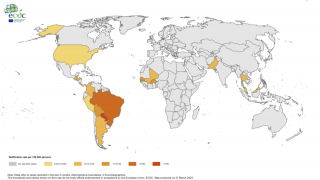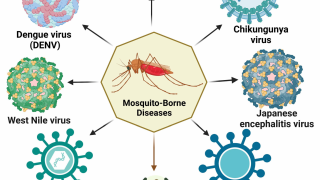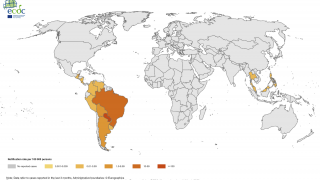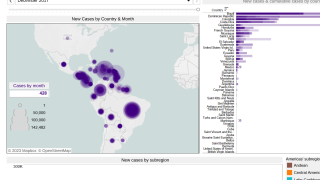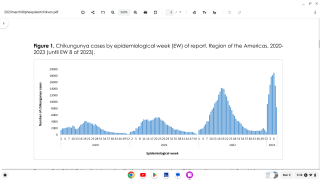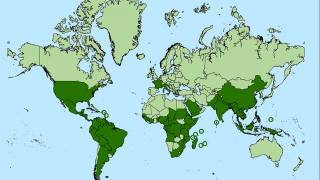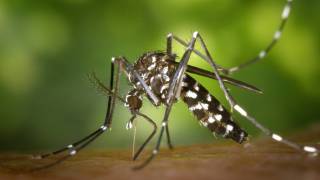Chikungunya Vaccine Candidate Engineered Using a Synthetic Protein Scaffold

Researchers from the University of Bristol and the French National Centre for Scientific Research (CNRS) in Grenoble, France, teamed up with Oracle to design a first-in-kind ADDomer-based vaccine candidate, to combat the Chikungunya infectious disease.
The findings, published in Science Advances on September 25, 2019, reveal exceptionally promising results for a Chikungunya virus vaccine candidate, which has been engineered using a synthetic protein scaffold that could revolutionize the way vaccines are designed, produced and stored.
This is important news since there is no vaccine to prevent or medicine to treat the Chikungunya virus today.
These researchers created ADDomer, an adenovirus-derived multimeric protein-based self-assembling nanoparticle scaffold, engineered to facilitate the plug-and-play display of multiple immunogenic epitopes from pathogens.
They used cryo-electron microscopy at near-atomic resolution and implemented novel, cost-effective, high-performance cloud computing to reveal architectural features in unprecedented detail.
"We were working with a protein that forms a multimeric particle resembling a virus but is completely safe because it has no genetic material inside, said Pascal Fender, an expert virologist at CNRS, in a related press release.
"Completely by chance, we discovered that this ‘particle’ was incredibly stable even after months, without refrigeration."
Imre Berger, Director of the Max Planck-Bristol Centre for Minimal Biology in Bristol, added: "We figured that we could insert small, harmless bits of Chikungunya to generate a virus-like mimic we could potentially use as a vaccine."
To validate their design, the scientists employed cryo-electron microscopy, a powerful new technique recently installed in Bristol's state-of-the-art microscopy facility headed by Christiane Schaffitzel, co-author of the study.
Cryo-EM yields very large data sets from which the structure of a sample can be determined at near-atomic resolution, requiring massive parallel computing.
Enabled by Oracle's high-performance cloud infrastructure, the team developed a novel computational approach to create an accurate digital model of the synthetic vaccine.
University of Bristol IT specialists Christopher Woods and Matt Williams, together with colleagues at Oracle, implemented software packages seamlessly on the cloud in this pioneering effort.
Christopher explained: "We were able to process the large data sets obtained by the microscope on the cloud in a fraction of the time and at a much lower cost than previously thought possible."
"Researchers have had a long tradition of building and installing their own supercomputers on-premises, but cloud computing is allowing them to run large data sets in record time, with fast connectivity and low latency.”
“This is helping them crunch data and make scientific breakthroughs much faster. Going forward, technologies like machine learning and cloud computing will play a significant part in the scientific world, and we are delighted we could help the researchers with this important discovery," added Phil Bates, leading cloud architect at Oracle.
The particles the scientists designed yielded exceptionally promising results in animal studies, soundly setting the stage for a future vaccine to combat Chikungunya disease.
Imre Berger continued saying “Our vaccine candidate is easy to manufacture, extremely stable and elicits a powerful immune response. It can be stored and transported without refrigeration to countries and patients where it is most needed.”
“Intriguingly, we can now rapidly engineer similar vaccines to combat many other infectious diseases just as well,” concluded Berger.
This innovation is important as infectious diseases continue to plague populations worldwide.
Among the means at our disposal to counter this threat, vaccination has proven to be exceptionally powerful.
However, severe challenges to human health persist, evidenced by epidemics caused by Ebola, Zika and other viruses, said these researchers.
A recent example is Chikungunya, a virus transmitted by the bite of an infected mosquito. The symptoms of chikungunya are similar to those of dengue and Zika, says the US Centers for Disease Control and Prevention (CDC).
Chikungunya vaccine news
- Vector-Based Platform Gains Merck Partnership
- Brazil’s Ongoing Disease Outbreaks - September 2019
- Ethiopia Disease Outbreaks: Chikungunya, Cholera, Measles, Poliovirus
The Chikungunya disease causes crippling headache, vomiting, swelling of limbs and can lead to death. Even if a fever ends abruptly, chronic symptoms such as intense joint pain, insomnia, and extreme prostration remain.
Formerly confined to sub-Saharan Africa, Chikungunya has recently spread worldwide as its mosquito host leaves its natural habitat due to deforestation and climate change, with recent outbreaks in the USA and Europe causing alarm.
As of September 17, 2019, Chikungunya cases have been reported in numerous countries around the globe.
As of September 5, 2019, a total of 57 Chikungunya virus disease cases with illness onset in 2019 have been reported from 21 U.S. states.
All reported US Chikungunya cases occurred in travelers returning to the USA from affected areas. No locally-transmitted cases have been reported from U.S. states during 2019.
These authors would like to thank the Finovi Foundation, the Agence National de Recherche (ANR), EPSRC, BBSRC, Wellcome Trust and GW4 for their support. No conflicts of interest were disclosed.
Chikungunya news published by Precision Vaccinations
Our Trust Standards: Medical Advisory Committee


